It should always be kept in mind that the carillon's principal task was originally marking the hours of the day and, later, the quarters of the hour with melodies, known as the "voorslag." The voorslag served to draw the attention of the busy townsfolk to the subsequent clock strokes. This task was historically accomplished through the automatic chiming of one or more bells, as is still practiced in countries without a significant carillon tradition. Therefore, the voorslag can be regarded as the precursor to the fully developed carillon that later emerged in the Low Countries.
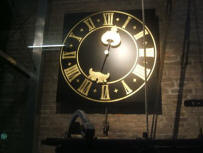
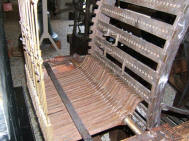
Automatic time-measuring systems have a long history dating back to ancient Greek, Roman, and Arabian cultures who had created impressive astronomical clocks. These ancient "water clocks" were driven by running water. However, in Northern Europe, hydraulic power was impractical due to the freezing of water during the prolonged, cold winters. Consequently, by the end of the thirteenth century, running water was replaced by a weight, and the concept of regularly running water as a basis for measuring time gave way to the so-called balance or foliot. This new clock, which likely invented in England,André Lehr, The Art of the Carillon in the Low Countries (Tielt: Lannoo Printers & Publishers, 1991), 82. was more compact, easier to construct and more accurate than the water clock. The introduction of the pendulum by Christiaan Huygens in 1657 marked a significant advancement. Initially, a single hand sufficed, but with technical refinements towards the end of the nineteenth century, the minute hand was introduced.
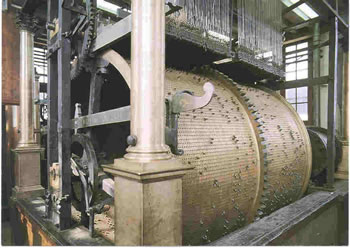
by Pieter Hemony. The nootjes on the drum and
the wires for lifting the hammers are visible. Saint Jans tower in Gouda. The drum was made in 1691 by Frederik van den Berk.
Video clip from: Beiaard van de St. Janstoren te Goudahttp.
In the Netherlands, carillons were often integrated with tower clocks to play melodies every quarter-hour using an automatic chiming system. Such systems, dating back to the early Middle Ages, are seen as forerunners to the widely cherished music boxes. These boxes generate sound through a series of pins set on a revolving cylinder or disc. As the drum rotates at a steady pace, the melody unfolds. Typically made of metal and spring-powered, the cylinders in these music boxes are essential to the musical output. In more elaborate models, the cylinders—serving as interchangeable musical programs—could be swapped out to introduce new melodies.
The automatic chiming mechanism in carillons utilized hammers to externally strike the bells. Initially, the large drum or speeltrommel comprised two forged-iron wheels with strips for removable note-pins, linked to the tower clock. Over time, these cylinders evolved to be made of brass and were cast as a single piece.
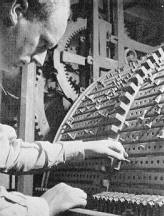
Re-pinning of a new melody, Oude Kerk Amsterdam.
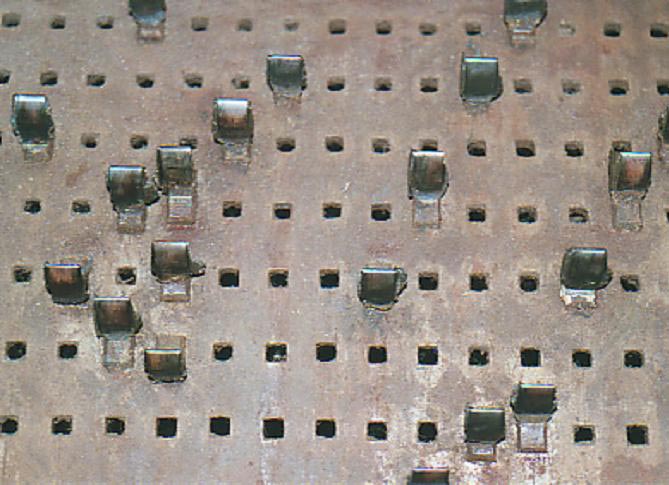
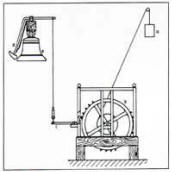
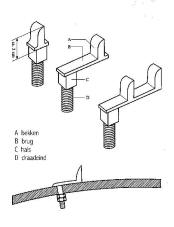
When the drum-weight (as illustrated in the black and white schematic drawing to the right) is released by the tower clock (typically every quarter-hour), it starts rotating to the right. As each pin (referred to as nootjes) passes underneath the lever (known as "the lichter," located on the left), it triggers the vertical wire to be pulled downwards, consequently lifting the hammer. The hammer then falls back precisely onto the sound bow of the bell just as the pin clears the lever, allowing the lever to return to its original position. Similar to the clapper mechanism, a return spring positioned under the hammer retracts it after striking, ensuring that the bell can resonate fully.
The responsibility of setting the pins on the drum, a process known as versteken, lies with the carillonneur, often assisted by a clockmaker. This task involves arranging the pins to match the musical pattern of the melody. While it is possible to change melodies by re-arranging the pins, this is a labor-intensive and time-consuming task that requires meticulous care. Typically, re-pinning the drum to play four different melodies for each quarter-hour requires two full days. Nowadays, this re-pinning process is carried out up to three or four times a year.
To audibly differentiate the various segments of an hour (especially useful when the tower clock is not visible, such as at night), the melodies vary in length. A partial melody is played for the quarter hours, approximately half a tune for the half-hour, and a complete tune for the full hour.
The Development of the Carillon to a Full Musical Instrument: The Daily Musical Practice
Regrettably, there are no direct historical sources documenting the specific music played on carillons during their early development in the sixteenth century. Therefore, our understanding is primarily based on general inferences drawn from indirect sources. It is highly probable that the melodies rendered by the automatic chime systems were predominantly of a religious nature, such as well-known church hymns and psalm settings. Additionally, those overseeing the carillons had to consider the limitations of the early mechanical systems and the bell ranges. Moreover, the bells were not always flawlessly tuned. Consequently, there was a preference for music featuring simple melodic lines and uncomplicated harmonies that could accommodate these constraints.
Despite these challenges, bell founders and clockmakers diligently worked to enhance both the mechanical systems (for automatic chiming and manual playing) and the casting and tuning techniques. However, improvements in tuning were not always markedly successful. Their efforts laid the groundwork for the gradual evolution and refinement of carillon music and its instrumentation.
In general, those who commissioned a carillon, in most cases the municipalities, also chose which kind of music would be played. After the reformation had swept over the Northern Netherlands, we know that the 1586 synod at Edam complained about "the playing of inconsiderate and secular songs on bells and organs" and that they demanded that the local secular authorities to ensure this would not happen again.André Lehr, The Art of the Carillon in the Low Countries (Tielt: Lannoo Printers & Publishers, 1991), 110. Similar orders were issued to the municipal carillonneurs of other cities (Antwerp in 1580/1581) to avoid "improper or offensive ballads, melodies or poems" and to confine themselves to "certain psalms, sacred or edifying melodies and hymns of praise."André Lehr, The Art of the Carillon in the Low Countries (Tielt: Lannoo Printers & Publishers, 1991), 110.
However, the initial restrictions quickly ebbed because carillons were principally intended for the "honor and decoration" of the towns, as well as to communicate civic pride and prosperity to out-of-towners. In essence, carillon music was first and foremost for the enjoyment of the public listeners. In several towns local authorities and carillonneurs agreed to play psalms and hymns during Sunday recitals and a variety of music, at their discretion, on weekdays whatever the carillonneurs wished. Most likely they chose popular melodies and dance music. As was and still is customary, carillonneurs derived the basics of the melodies from music books adjusting the harmonies and rhythm while improvising in a clear, uncomplicated manner.
"Like piano music, carillon music is written on two staves: the music on the treble, or upper, staff is played with the hands, while that on the bass or bottom staff is played with the feet. Care must be taken when composing or transcribing music for the carillon. One feature that distinguishes the carillon from other instruments is the fact that once a bell is struck, it continues to ring until the vibrations die out naturally. All of the musical expression of which the carillon is capable is controlled by how the performer strikes the bell. There is no way to stop or alter the sound of a struck bell. Dampers are ineffective because they just deaden the sound without stopping it, rendering it unmelodic. Lastly, the ample tonal structure of a bell means that sounding a large number of bells together is unnecessary. A rich sound can be obtained from just a few bells." The Guild of Carillonneurs in North America (GCNA)
What Kind of Music was Played in Vermeer's Time?
In the second half of the seventeenth century, the new, well-tuned chromatic carillons of the Hemony brothers, with their increasing range in size, marked a decisive step in the development of the carillon into a full-fledged musical instrument. Unfortunately, much of the music from past players has been lost and for various reasons little to none was published. Private collections were lost or destroyed over the years so extant examples are exceedingly rare. Indirect evidence of the choice of music may be suggested by a report of the Delft organist and carillonneur Dirck Scholl (1641–1727) during the famous dispute with Quirinus van Blankenburg (1654–1740) from Gouda. This report addresses the necessity of the Cis and Dis in the bass bells of a carillon.Pieter Hemony/Dirck Scholl, De on-noodsakelijkheid en ondienstigheid van cis en dis in de bassen der klokken. Delft 1678. Scholl pointed to the fact that the bass notes do not occur in the French or Italian compositions. Evidently, foreign music had found its way into the carillon repertoire in parallel to the keen interest in the French and Italian culture that the Dutch middle and upper classes had developed. In the program of one of the first carillon concerts in Alkmaar in 1687, we encounter titles like Bellinde, Petit Bergère or Ballet van Alcmaar,André Lehr, The Art of the Carillon in the Low Countries (Tielt: Lannoo Printers & Publishers, 1991), 163. undoubtedly of French origin.
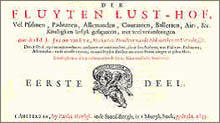
Part, 1646.
Carillonneurs often played music originally composed for other instruments. A famous example is Jacob van Eyck's Der Fluyten Lust-Hof (1644–1649). Its title page states: "Dienstigh voor alle Konst-lievers tot de Fluit, Blaes- en allerley Speel-tuigh" ("Of use to all lovers of art on the recorder, wind and diverse playing-instruments"), which undoubtedly included the carillon. Therefore, it is reasonable to assume that Van Eyck's celebrated volumes likely provide an accurate representation of a carillonneur's repertoire, predominantly featuring popular tunes from France, Italy, or England, alongside sacred music. Its title page reads: "Vol Psalmen, Paduanen, Allemanden, Couranten, Balletten, Airs, etc. …"The latest research to the question whether Van Eyck had written some pieces (psalms in particular) from his Fluyten Lust-Hof at first for the carillon has recently been made by Van Eyck expert Thimo Wind in his thesis of May 2006. This would mean that not Matthias van den Gheyn (1725–1785) but c. one hundred years earlier Jacob van Eyck was the first who wrote music specifically for the carillon. For a detailed report about Mr. Wind's research and his thesis see Foecke de Wolf and Henk Veldman, "Der Klocken Lust-Hof?" in: Klok & Klepel 98, March 2007. Ed. Nederlandse Klokkenspel-Vereniging. (Dutch only), accessed November 27, 2023. An English translation of the thesis is in preparation.
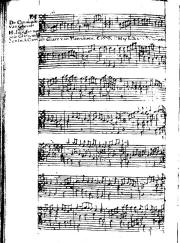
The first direct musical sources are two Flemish versteekboekjes or "re-pinning books" for carillons with automatic chiming systems. For proper tune setting, it was necessary to write down the music to avoid mistakes and efficiently utilize the drum's space. The earliest of these re-pinning books were compiled by Théodore de Sany (1599–1658), Brussels' municipal carillonneur. De Sany had collected sisxty pieces of music, composed for the automatic chiming system of Saint Nicolas Church and dedicated the book in 1648 to the Brussels authorities in an attempt to gain their favor.André Lehr, The Art of the Carillon in the Low Countries (Tielt: Lannoo Printers & Publishers, 1991), 164. The book contains religious music for important liturgical feasts of the Church year: such as Advent, Christmas, Easter, Whitsuntide etc., but also arrangements of French chansons, Flemish May-tunes or Italian madrigals. The quality of Sany's arrangements is somewhat lacking in originality.
The other re-pinning book was compiled by the Dominican friar Philippus Wyckaert (1620–1694) for the carillon in the belfry of Ghent. It was entitled Den Boek van den voorslach van Ghendt ("Book of the chime of Ghent") and dedicated in 1681 to the city magistrate. It contains eighty-three pieces mostly of religious music whose melodies, however, were less related to official church music than to the common people's taste. Secular tunes are also to be found, like melodies for processions and cavalcades, drinking songs, the inevitable dances and even a number of the new opera melodies, a fine selection from the musical panorama of the time. Wyckaert made it clear that the municipal carillonneur should re-pin music that the population knew and enjoyed.
Wyckaert benefited from the technical improvements made to the Ghent drum by Juriaan Sprakel in 1663. Starting with the initial unison melodies, he increasingly progressed towards more complicated musical arrangements.
We can assume with certainty that the same or a very similar kind of music played by the automatic chime had also been performed by the carillonneurs.
The Eighteenth Century: the Golden Age of Carillonneurs
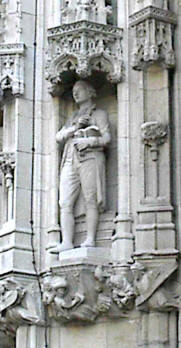
The eighteenth century was the zenith for carillonneurs in the Low Countries. Since many carillonneurs served as municipal organists as well, they fulfilled an important public function and were highly regarded. Some were sought out as technical advisors for the two instruments. The great interest in the function of a carillonneur/organist was testified by a comparatively hefty number of replies to advertisements for vacant posts which made competitive examinations necessary.
Carillon concerts must have been much more frequent than they are today. Three to four concerts a week were common, apart from music played during municipal processions, celebrations, public and private festivities and, of course, during market days. In addition, the municipal carillonneur provided new music for the drum every two or three months. The choice of music was generally left to his discretion but it was assumed that he would choose psalms and music which were proper for the time of the (Church) year.
One of the most prominent carillonneurs of that era was undoubtedly Matthias van den Gheyn (1721–1785) from a celebrated Flemish family of bell founders, carillon builders and carillonneurs. Van den Gheyn was a brother to the renowned bell founder Andreas Jozef van den Gheyn. Beginning in 174, he was organist at Sint-Pieterskerk in Leuven and from 1745 the municipal carillonneur of the town. Van den Gheyn, deeply committed to his societal role, often exhibited his skill in celebrated performances, particularly excelling in improvisation. André Lehr wrote:André Lehr, The Art of the Carillon in the Low Countries (Publisher: Lannoo, 1991),196.
Contemporaries relate how Van den Gheyn, in an immaculate, fashionable black suit, stylishly holding his walking stick and affably greeting friends and admirers, scanned the market to see if there were perhaps strangers who had come to listen to his renowned carillon playing. After twenty minutes he disappeared into the tower of St Peter's where he discarded the fashionable clothing and thereupon opened his concert with a number of preludes. That was only the introduction however, as time and again, the highpoint was in the form of his very original improvisations which could last for half an hour. Van den Gheyn knew very well that this unrestricted playing was of an exceptional character, as afterward he appeared once more among his admirers to accept their compliments, dressed in just as immaculate a suit as before the concert.
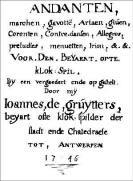
Antwerp 1746.

Portrait of Frederik Johan Berghuys
(1762–1835)
Anonymous artist
Delft, Diaconie der Nederlands
Hervormde Gemeente.
Van den Gheyn was widely regarded as the most gifted carillonneur of his era and also an expert restorer of organs and carillons. Furthermore, his outstanding qualities as a composer were evident in a number of compositions for harpsichord, organ and carillon which were discovered in manuscript form around 1861 by Xavier van Elewyck. The eleven virtuoso preludes for carillon were long considered as the earliest surviving genuine compositions for this instrument. At the very least, these preludes represent an initial step toward more original compositions for the carillon. Due to their strict structure and toccata-like character, Van den Gheyn was called the "Bach of the Carillon." To this day, his preludes remain part of the standard repertoire of every good carillonneur. Another carillon manuscript, titled Leuvens Beiaardhandschrift (Louvain Carillon Manuscript) from 1756, was likely overseen by Van den Gheyn. It contains 151 pieces of dance music, marches, and music for formal occasions.
Another famous carillonneur of that time was Joannes de Gruytters (1709–1772), town carillonneur of Antwerp. The title-page of his manuscript gives detailed information about the content: "Andantes, marches, gavottes, arias, gigues, courantes country dances, allegros, preludes, minuets, trios &.&. For the carillon or bell-chime collected and put together by Joannes de Gruijtters, carillonneur or bell-ringer of the town and cathedral of Antwerp 1746").André Lehr, The Art of the Carillon in the Low Countries (Tielt: Lannoo Printers & Publishers, 1991), 198.
This volume contains 194 pieces, primarily arrangement by Lully, Corelli, Couperin, Vivaldi, Handel and Locatelli, but also from local composers such as Willem De Fesch (1687–1757) or Joseph-Hector Fiocco (1703–1741), with only four pieces expressly composed for the carillon by de Gruytter, Jan Jozef Colfs, and Boudewijn Schepers. This book is another example of the preference for the French and Italian music in that time – "the nicest in the art of music" as Peter Hemony and Dirck Scholl had previously emphasizedin a dispute almost a century earlier.André Lehr, The Art of the Carillon in the Low Countries (Tielt: Lannoo Printers & Publishers, 1991), 162
The oldest preserved Dutch carillon music came from the well-known carillonneurs of Delft, Johannes Berghuys (1724–1801) and his son Frederik Johan (1762–1835).Information about Johannes and Frederik Johan Berghuys from: Laura Johanna Meilink-Hoedemaker, "Luidklokken, Klokkenspel en Klokkenisten," in De Stad Delft: cultuur en maatschappij van 1667 tot 1813, ed. Ineke V. T. Spaander (Delft: Stedelijk Museum Het Prinsenhof, 1981), 167–168. Both were accomplished carillonneurs and organists. For instance, Johannes received visits from renowned colleagues like Joachim Hess from Gouda and Jacob Potholt from Amsterdam, who specifically traveled to Delft to listen to his carillon performances. Furthermore, he served as advisor for the carillons and organs in Brielle, Schiedam, Gouda or Tours. After his death, his son Frederik Johannes succeeded him in the post of the municipal carillonneur and organist. Several contemporaries recognized his virtuoso playing. He excelled in the re-pinning of melodies for the automatic chime. Like his father, he documented much of the carillon music. Several of these books, titled Muziek voor het Carillon in de Toren van de Nieuwe Kerk (1776–1835), are preserved at the Regionaal Historisch Centrum Delft. Frederik Johan also served as an advisor in the sale of some of Delft's last swinging bells in 1808.